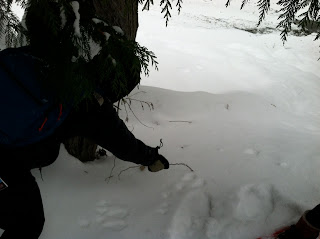On Saturday morning, a determined group of eight gathered near the cozy fire in the North Cascades Basecamp Lodge. We listened as our animal tracking guide, Gabe Spence, described his experience learning about tracks, following animals footprints in all environments, and how we would do just that here in the Methow.
 |
The group examines our
first track sighting |
As we embarked into the snowy landscape in Mazama, the conditions proved perfect for tracking. The sun was shining, the snow was soft, the temperature cold enough (as in 3 degrees...brrr!) to have preserved every movement of the animals over the last 3 days.
 |
| Gabe identifying tracks |
With Gabe’s help, the group quickly spotted tracks with two large imprints in front and two smaller and offset imprints behind. The medium sized animal must hop given the distance between the tracks, and since frogs are out of the season, we decided on the snowshoe hare.
 |
| Snow shoe hare track |
These quick and industrious hares seem to do well in this environment as we saw their tracks on many occasions. The low hanging trees provide fir needles, buds and twig snacks for their seasonal diet. Deer, whose tracks we also found close by in the forest, also devour similar woody treats during the winter season.
Not only were we able to identify animal tracks, but many of the prints in the snow told the story behind the animal’s movement. Our investigations found motivation behind an animal’s directional movements and the speed of their gait. As one member of the group said, “we are like detectives, using clues to tell us what happened!”
 |
| The group following coyote tracks near Beaver Pond |
Before returning for lunch, we followed tracks we initially believed to be one coyote. Our group carefully walked alongside the prints and eventually recognized that three coyotes were tracking lunch of their own
The coyotes’ footprints led us to a tree where we found another animal’s tracks and remains of their lunch: pine cone remnants. Clearly, the coyotes were hoping to feast on unsuspecting red squirrels. The coyotes’ movements through the trees harboring squirrels explained their thinking and know-how to find their prey.
After warming our cold toes by the fire and a hearty lunch at the Basecamp, we drove to another site in Mazama where Gabe frequently spots cougars. Though we did not find cougar evidence on this day, we found many tracks that would likely be a cougar feast. Deer, weasel, field mice, and coyote tracks lay preserved for examination.
 |
Small tracks hurried for
shelter in the snow |
We finished our tracking day by following a deer. Deer tracks are usually clearly identifiable but can be tricky depending on the snow conditions. Their long, thin legs and heavy bodies leave connected strides forming a squared off trough in the deep snow where many deer have walked.
In the deep now, deer, much like snow shoers, will generally follow one another, staying in the tracks already laid by another thus saving time and energy. In the deep powder snow, it was difficult to determine the direction of travel since last week’s snow most often fell into the tracks, obscuring the actual footprint. After much discussion, we learned from Gabe that in these conditions, the leading pointed edge of the hoof where the track is deeper indicates the direction the deer traveled.
 |
| The group after a fun day following tracks! |
It was with trepidation that many members of the group took off gloves to put their hand into the snow of the deep track. They found out which direction the deer was walking, exposing their fingers to the frigid temperatures. We continued following the tracks which eventually led us to our parked cars. The deer must have known we were all chilly after an exciting day in the great outdoors.
 Celeste helped us find our communal beat and together we sang, chanted and enjoyed the warmth of the fire against the winter night.
Celeste helped us find our communal beat and together we sang, chanted and enjoyed the warmth of the fire against the winter night.





























